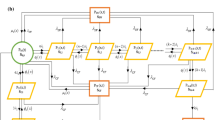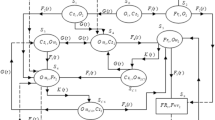Abstract
This paper deals with cost benefit analysis of a single server two non-identical unit cold standby system with two modes of each unit: Normal and Total failure. One unit gets priority in operation as well as in repair over the other unit. The switching device to put the standby unit into operation is always perfect and instantaneous. Failure and repair time distributions of each unit are taken as Weibull with common shape parameter and different scale parameters. The system is observed at suitable regenerative epochs to obtain various measures of system effectiveness of interest to system designers and operation managers.




Similar content being viewed by others
Notes
The limits of integration are 0 to ∞ whenever they are not mentioned.
References
Brkic DM (1990) Interval estimation of the parameters β and η of the two parameter Weibull distribution. Microelectron Reliab 30(1):39–42
Dhillon BS (1984) Stochastic model for evaluating probability of system failure due to human error. Microelectron Reliab 24:921–924
Dhillon BS, Natesan J (1975) Stochastic analysis of outdoor power system in fluctuating environment. Microelectron Reliab 23:867–881
El-Said Khaled M, El-Sherbeny Mohamed S (2010) Stochastic analysis of a two-unit cold standby system with two-stage repair and waiting time. Sankhya-B 72(1):1–10
Gupta R, Chaudhary A (1992) A two unit priority standby system subject to random shocks and Rayleigh failure time distribution. Microelectron Reliab 32(12):1713–1723
Gupta R, Goel CK, Tomer A (2010) Cost-benefit analysis of a three unit standby system with delayed replacement, repair and post repair. Rajasthan Acad Phy Sci 9:41–50
Nakagawa T, Osaki S (1976) A summary of optimum preventive maintenance policies for two unit standby redundant system. Oper Res 20:171–187
Okumato K, Osaki S (1977) Optimum policies for a standby system with preventive maintenance. Oper Res Q 28:415–523
Osaki S, Okumato K (1977) Repair limit policies for a two unit standby redundant system with two phases repair. Microelectron Reliab 16:14–45
Acknowledgments
The authors are highly grateful to the learned reviewers as well as editor of the journal for making critical comments and suggestions for improvement the quality of the article.
Author information
Authors and Affiliations
Corresponding author
Rights and permissions
About this article
Cite this article
Gupta, R., Kumar, P. & Gupta, A. Cost benefit analysis of a two dissimilar unit cold standby system with Weibull failure and repair laws. Int J Syst Assur Eng Manag 4, 327–334 (2013). https://doi.org/10.1007/s13198-012-0091-z
Received:
Published:
Issue Date:
DOI: https://doi.org/10.1007/s13198-012-0091-z




